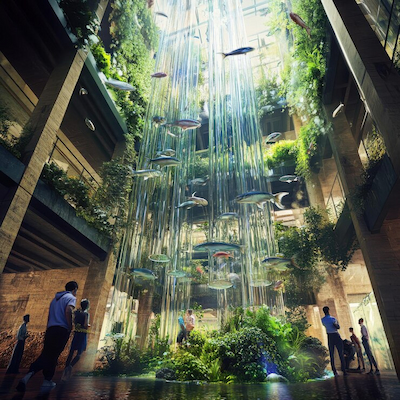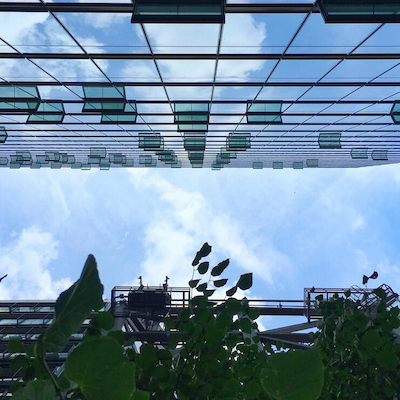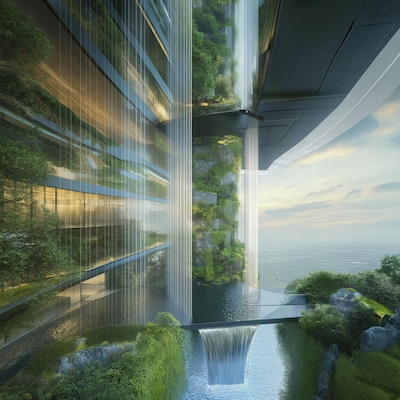
Sustainability in contemporary architecture is an increasingly relevant topic, especially in a world facing unprecedented environmental challenges. The need to build responsibly and consciously has become urgent as the consequences of climate change become more evident. Architecture, as a primary driver in transforming urban and rural environments, plays a crucial role in promoting sustainable practices.
In this context, sustainability goes beyond the use of eco-friendly materials or waste reduction. It involves a holistic approach that considers a building’s entire lifecycle, energy efficiency, and social impact. Architects and urban planners are increasingly integrating these principles into their projects, creating spaces that meet human needs while respecting the environment.
How the Principles of Sustainability Work in Contemporary Architecture
The principles of sustainability in contemporary architecture operate through guidelines designed to minimize a building’s environmental impact. One major consideration is energy efficiency: using technologies and methods that reduce energy consumption, such as solar panels, efficient heating and cooling systems, and natural daylight. These strategies not only lower carbon emissions but also reduce long-term operating costs.
Choosing sustainable materials is another fundamental principle. This involves selecting products with minimal environmental impact, recyclability, or renewable sources. Using locally sourced materials is encouraged to reduce the carbon footprint associated with transportation. Evaluating the materials’ life cycles—from extraction and production to disposal and reuse—is essential.
Water management is also critical in sustainable architecture. Projects that incorporate rainwater harvesting systems, greywater reuse, and native landscaping help conserve precious water resources. Greens roofs and vertical gardens contribute to biodiversity, improve air quality, and create more pleasant environments.
Finally, sustainability in contemporary architecture requires designing spaces that promote human well-being. This means considering factors like natural ventilation, thermal and acoustic comfort, and social interaction. Sustainable architecture is not just about what is built but also how those spaces affect people’s lives.

Advantages of Adopting Sustainability in Contemporary Architecture
Adopting sustainability in contemporary architecture offers benefits beyond environmental preservation. First, it can result in significant savings on operational costs. Energy-efficient buildings consume less energy, leading to lower utility bills. Durable, low-impact materials reduce the need for frequent maintenance and repairs.
Sustainable buildings are also increasingly desirable in the real estate market, attracting buyers and tenants who value environmental responsibility. This can lead to higher property values and occupancy rates compared to conventional buildings.
Sustainability directly contributes to occupants’ health and well-being. Well-designed environments that prioritize air quality, natural lighting, and thermal comfort promote physical and mental health. This is especially important in workplaces, where environmental quality affects productivity and satisfaction.
Finally, sustainable architecture can positively impact the community. Projects that include public spaces, green areas, and sustainable mobility solutions help build cohesive, resilient neighborhoods. This enhances residents’ quality of life and fosters a collective sense of environmental responsibility.
How to Implement Sustainability in Contemporary Architecture
Implementing sustainability in contemporary architecture involves steps adaptable to various contexts and project types. First, conduct a comprehensive site analysis, assessing climate, topography, and local ecology to ensure the design harmonizes with the environment.
Next, set clear sustainability goals from the start, covering aspects like energy efficiency, water management, sustainable materials, and promoting occupant well-being. Integrate these objectives into the planning and design process so that every aspect of the project adheres to sustainability principles.
Working with a multidisciplinary team is essential. Architects, engineers, landscape designers, and sustainability specialists should collaborate from day one, creating innovative solutions that meet project requirements while minimizing environmental impact. This cooperation often leads to creative, effective approaches.
Finally, occupant education is crucial to ensure sustainable practices persist over time. Implement training programs on resource-efficient usage and encourage green behaviors among users. Sustainability does not end with construction—it requires ongoing commitment from everyone involved.
The Role of Technology in Advancing Sustainable Architecture
Technology plays a crucial role in pushing the boundaries of what sustainable architecture can achieve. From digital design tools to smart building systems, innovations are enabling architects to design and construct buildings that are more efficient, responsive, and environmentally friendly than ever before.
One of the most impactful technologies is Building Information Modeling (BIM). BIM allows architects and engineers to create detailed digital models of buildings, enabling them to analyze everything from energy consumption to material efficiency during the design phase. This predictive modeling leads to better decision-making and helps avoid costly errors or unsustainable practices during construction.
Smart building technologies are also transforming how buildings operate after construction. Automated systems can monitor and adjust lighting, heating, cooling, and ventilation in real-time, optimizing energy use based on occupancy and environmental conditions. These systems not only reduce energy consumption but also improve occupant comfort and productivity.
Materials science is another area where technology is making strides. New sustainable materials, such as carbon-negative concrete, bioplastics, and recycled composites, are being developed to replace traditional, high-impact construction materials. Innovations like self-healing concrete and solar glass show how materials themselves can actively contribute to a building’s sustainability.
Additionally, technology facilitates green certifications and monitoring through platforms that track carbon footprints, water use, and waste generation. These tools help architects meet international standards like LEED, BREEAM, and WELL, pushing the industry toward more rigorous and measurable sustainability benchmarks.
By embracing technological advancements, architects and developers can create smarter, greener, and more resilient buildings that meet both current needs and future environmental challenges.
Community-Centered Design: Social Sustainability in Architecture
While environmental sustainability often takes the spotlight, social sustainability is equally important in contemporary architectural practice. Community-centered design places people at the heart of architectural decisions, ensuring that buildings and spaces support inclusive, equitable, and connected communities.
Social sustainability in architecture begins with listening. Architects engage with local communities during the planning phase to understand their unique needs, values, and aspirations. This participatory approach fosters a sense of ownership and ensures that developments truly serve the people who use them.
Accessibility and inclusivity are key elements of socially sustainable design. This means creating spaces that are usable and welcoming to everyone—regardless of age, ability, or socioeconomic background. Incorporating universal design principles ensures equitable access to housing, education, healthcare, and public services.
Public and communal spaces also play a vital role. Parks, plazas, pedestrian-friendly streets, and cultural centers encourage social interaction and physical activity. These shared environments help reduce isolation, promote health, and strengthen neighborhood bonds.
Social sustainability also includes addressing housing affordability and resilience. Mixed-income developments, adaptable living units, and the use of cost-effective, sustainable materials can ensure that high-quality architecture is not exclusive to privileged communities.
Finally, integrating local art, traditions, and cultural identity into the built environment reinforces a sense of belonging and pride. When people see their values and stories reflected in the architecture around them, it contributes to stronger, more vibrant communities.
By designing with empathy and purpose, architects can foster environments where people not only live—but thrive—together.

Did You Enjoy Learning About Sustainability in Contemporary Architecture?
Sustainability in contemporary architecture is a fascinating and vital topic for the future of our cities and communities. By embracing sustainable practices, we protect the environment and create spaces that promote health and well-being. Understanding and applying these principles is essential for building a more conscious and responsible future.
If you’re interested in learning more about how sustainability shapes architecture and urbanism, keep exploring this field. Many case studies, resources, and innovations can inspire and guide you on your journey toward a more sustainable world.
Frequently Asked Questions
What is sustainability in contemporary architecture?
Sustainability in contemporary architecture is about building in ways that avoid harming the environment. It involves using recyclable materials and designing energy-efficient structures.
What are the benefits of sustainable architecture?
Benefits include energy cost savings, waste reduction, and improved air quality. It also enhances comfort and can increase property value.
Is sustainability in architecture expensive?
It may seem costly at first, but over time you save on energy and maintenance. Sustainable investments usually pay off in the long run.
How does location choice impact sustainable architecture?
Choosing a site near public transportation and amenities reduces car dependence, cutting pollution and fostering more sustainable living.

